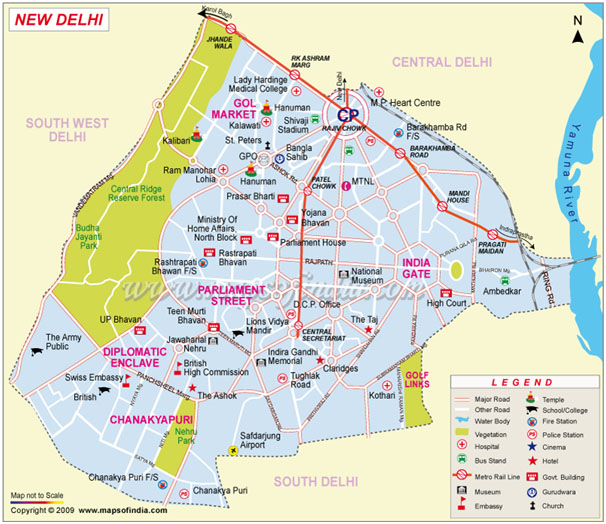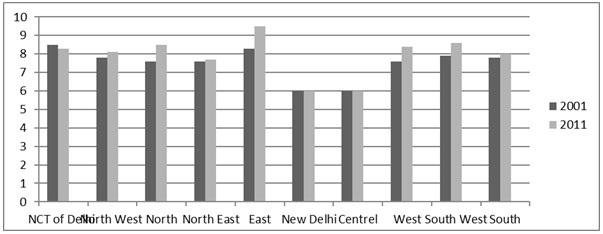
Commissioner and has three subdivisions. A Subdivision Magistrate heads each subdivision. All Deputy Commissioners report to the Divisional Commissioner. These districts are meant only for revenue collection & Administration.
New Delhi District: -A Scenario
The New Delhi District can be termed as the heart of NCT Delhi. It is located at the Centre and houses umpteen localities. It is also known as ‘Lutyens’ Delhi as most of the bungalows of the high-rank government officials, ministers, and other VIPs are situated here.
Landmarks: -
The Parliament, the President’s House and all Central Government Offices are situated in this area. Most of the important embassies are also housed in this area. The district is bestowed with evergreen trees, lush green parks, gardens including the famous Mughals Garden, Lodhi Garden, Nehru Park, etc. Being situated at the centre, this place is also the heart of business centre as most of the famous shops including state emporia, business companies, airlines and tourism offices, hotels and other establishments do brisk business. Most of the banks have their main office/branch at Connaught Place and adjoin areas. The basic amenities are well provided by New Delhi Municipal Council (NDMC) – a centralized and well-coordinated Government organization.
Rate Urban Literacy Rate- 2001-2011

Literacy Rate of All the District of Delhi is almost equal to each other, as far as the data 2011 census is concerned the literacy of New Delhi District is higher among the other the district.
Rural Literacy Rate- 2001-2011

Status of Literacy of New Delhi District
Literacy is one of key socio-economic progress meter of modern society and important aspect of Indian society. As per latest Indian Population Census 2011, India's literacy rate stands at 74.04 percent, an increase of 9.2% from the last decade. There is also wide gender disparity in the literacy rate of India as per census 2011 where literacy rate for male is 82.14 percentage while female stands at 65.46 percentage. Interestingly, in this decade (2001-2011), more women were added to literate population than men.
Literacy Rate of New Delhi District
| S. No | Literacy Rate | 2011 | 2001 |
|---|---|---|---|
| 1. | Total | 89.38 | 83.24 |
| 2. | Male | 93.04 | 88.62 |
| 3. | Female | 84.83 | 76.33 |
(As per Indian Population Census)
Total literacy rate of New Delhi in 2011 were 89.38 compared to 83.24 of 2001. If things are looked out at gender wise, male and female literacy were 93.04 and 84.83 respectively. For 2001 Census, same figures stood at 88.62 and 76.33 in New Delhi District.
Literacy scenario of New Delhi District
Number of Literate in New Delhi District
| S. No | Description | 2011 | 2001 |
|---|---|---|---|
| 1. | Number of Literates | 109,195 | 131,196 |
| 2. | Male | 63,005 | 78,540 |
| 3. | Female | 46,190 | 52,656 |
(As per Indian Population Census)
Total literatein New Delhi Districtis 109,195 of which male and female were 63,005 and 46,190 respectively in 2011. Whereas in 2001, New Delhi District had 131,196 in its total region with male and female literate in number 78,540 and 52,656 respectively. With regards to Sex Ratio in New Delhi, it stood at 811 per 1000 male compared to 2001 census figure of 792. The average national sex ratio in India is 940 as per latest reports of Census 2011 Directorate.
An Overview of New Delhi District
| 2011 | 2001 | |
|---|---|---|
| Actual Population | 133,713 | 179,112 |
| Male | 73,846 | 99,956 |
| Female | 59,867 | 79,156 |
| Population Growth | -25.35% | 6.19% |
| Area Sq. Km | 35 | 35 |
| Density/km2 | 3,820 | 5,117 |
| Proportion to Delhi Population | 1.29% | 0.80% |
| Sex Ratio (Per 1000) | 811 | 792 |
| Child Sex Ratio (0-6 Age) | 884 | 898 |
| Average Literacy | 89.38 | 83.24 |
| Male Literacy | 93.04 | 88.62 |
| Female Literacy | 84.83 | 76.33 |
| Total Child Population (0-6 Age) | 11, 549 | 21,496 |
| Male Population (0-6 Age) | 6,131 | 11,327 |
| Female Population (0-6 Age) | 5,418 | 10,169 |
| Literates | 109,195 | 131,196 |
| Male Literates | 63,005 | 78,540 |
| Female Literates | 46,190 | 52,656 |
| Child Proportion (0-6 Age) | 8.64% | 12.00% |
| Boys Proportion (0-6 Age) | 8.30% | 11.33% |
| Girls Proportion (0-6 Age) | 9.05% | 12.85% |


 DIET, R K PURAM, NEW DELHI
DIET, R K PURAM, NEW DELHI 


